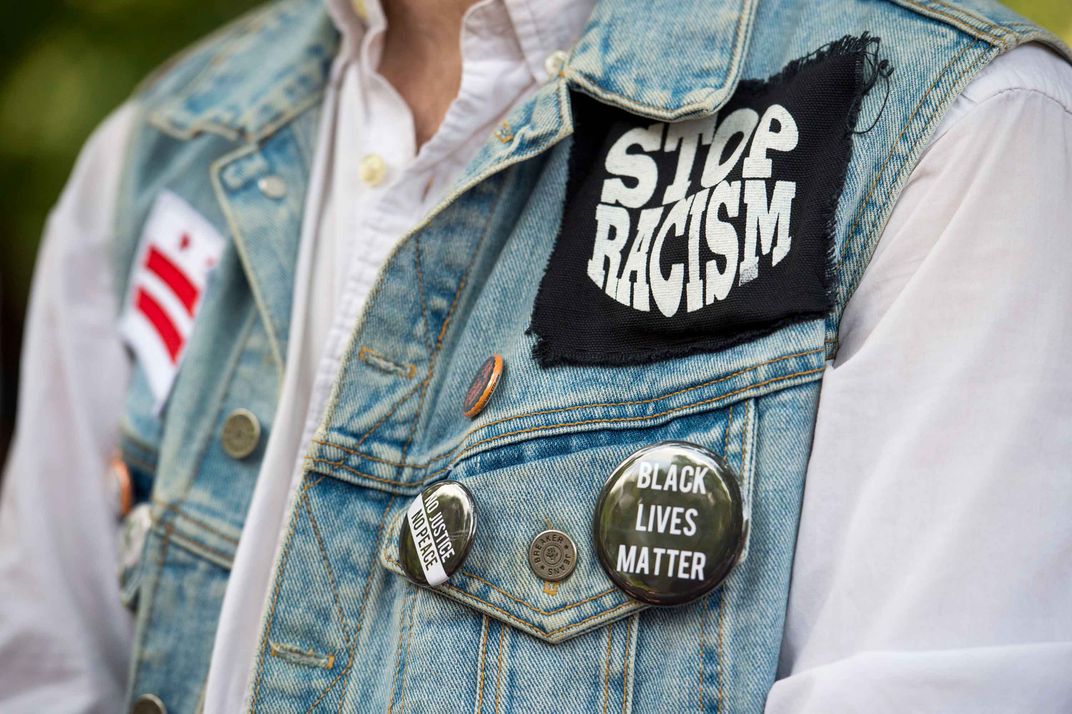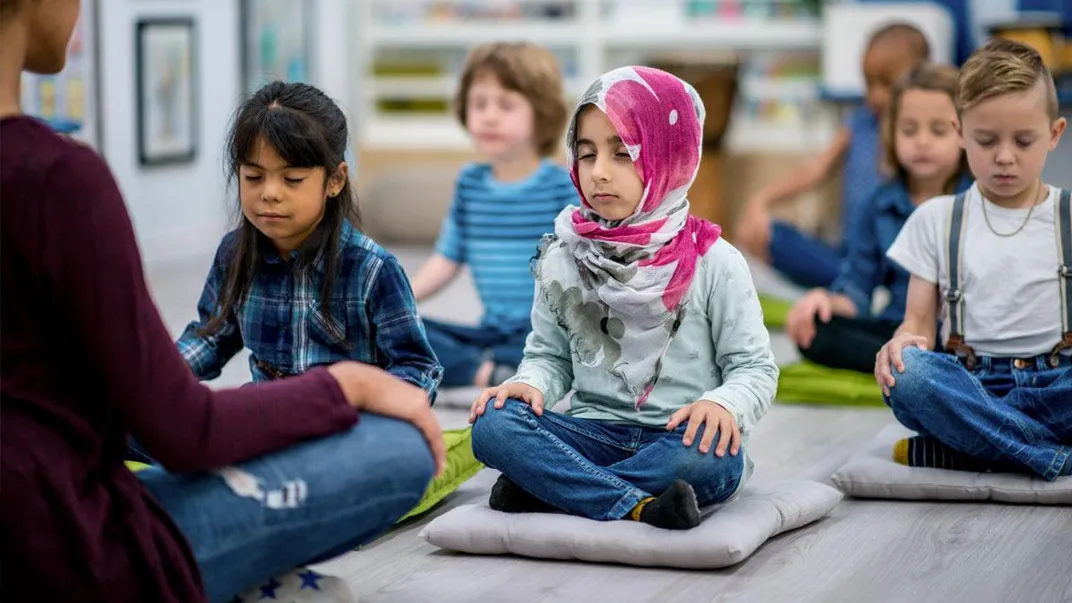How to Have That Tough Conversation About Race, Racism and Racial Identity
The Smithsonian’s African American History Museum debuts the online teaching tool “Talking About Race”
/https://tf-cmsv2-smithsonianmag-media.s3.amazonaws.com/filer/5b/cf/5bcffbe2-99df-4461-b8c9-16133b260fbf/topic-beantiracist_1.jpg)
The nation—and the world—have been glued to their televisions over the sadness and anger following the death of George Floyd. Scenes unfold of multi-racial crowds of people wearing masks in the midst of the Covid-19 global pandemic. Their hands are raised, they chant “we can’t breathe,” and they carry signs reading everything from “Black Lives Matter” to “Am I Next.” Then there are the images of the many demonstrators being tear-gassed, and others of looting and burning, and still more of both protestors and police officers alike being injured and in some cases killed. It has been heartbreaking, and terrifying.
“I think what I am feeling is that it is an important statement for our community to make about the way we have been treated, about the way we worry about just traversing this society, and the worry that somehow we might be singled out because of our color” says Spencer Crew, the interim director of the Smithsonian’s National Museum of African American History and Culture, when asked by CBS Radio News how he is feeling personally.
“I think with many others,“ Crew continues, “I am frustrated by that being a norm in society, and I am really hopeful that the kinds of frustration people are expressing will have an impact on those in leadership and help us move forward in terms of the kind of society we should be.”
Smithsonian Secretary Lonnie G. Bunch III, the founding director of the African American History Museum, earlier this week released a searing statement referencing the long list of people of color who have died at the hands of police and others, made even more poignant in the midst of the coronavirus pandemic, which has been disproportionately killing blacks, Latinos and Native Americans in this racially splintered nation.
“Not only have we been forced to grapple with the impact of a global pandemic, we have been forced to confront the reality that, despite gains made in the past 50 years, we are still a nation riven by inequality and racial division. The state of our democracy feels fragile and precarious,” Bunch wrote. “Once again, we struggle to make sense of the senseless. Once again, we bear witness to our country’s troubled history of racial violence, from Freddie Gray and Eric Garner to Sandra Bland and Trayvon Martin. Once again, we try to cope as best as we can, whether suffering in silence, participating in protests, or engaging in conversations that evoke all our emotions. Once again, we try to explain to our children that which cannot be explained. Once again, we pray for justice and we pray for peace.”
In the middle of it all, the museum launched the online portal, “Talking About Race,” to help people, educators, communities and families discuss racism, racial identity and how these concepts shape every aspect of our society from politics to the economy to the nation’s culture. The site is chock-full of digital and video tools, exercises and a host of multi-media resources. Crew thinks it will help drive discussions that are clearly critical at this juncture in history.

“I think what we know of our work at our museum over many, many years, is that one of the issues that worry people or challenge people the most is the idea of how do you talk about race? . . . We believe our portal will provide tools and guidance and a way of beginning to have those conversations because they are tough conversations,” Crew says. “I think people have a hard time figuring out how to enter into them, how to do them in ways that are fruitful, to do them in a way in which people don’t have to be worried about being judged for what they have to say, but can allow us to grow and to know each other better.”
The portal features eight foundational subjects, among them: “Community Building,” “Bias,” “Historical Foundations of Race,” “Race and Racial Identity,” “Self-Care,” “Social Identities and Systems of Oppression” and “Whiteness.” Crew thinks one of the most important offerings is the section called Being Anti-racist, defined as a “conscious decision to make frequent, consistent, equitable choices daily.”
“What it does, is suggest that we all carry biases,” he says, “but we want to be aware of those biases and begin to try to live our lives in a way in which we don’t let those control how we treat and interact with others.”
Anna Hindley, the museum’s director of early childhood education and the education department, along with the museum’s director of teaching and learning, Candra Flanagan, led a team of educators that spent years building the foundation of this portal.
“The work started with some separate experiences both Anna and I were involved in, . . . as we were thinking of how we wanted to bring the stories and the mission of the museum to life,” Flanagan explains. “We both began to come to the conclusion that we really needed to explicitly talk about identity, to talk about pride and love in one’s own identity. . . . And both of us also, we’re looking at the need for explicitly talking about race and identity in age appropriate ways within our own different target audience demographics.”
Hindley says she thought deeply about what race means for young children and their parents, and how this is a lifelong journey that begins the minute a child is born.
“Children are not color blind, and silence keeps children from understanding and learning so we must have these conversations throughout childhood,” Hindley says. “A good first step is to acknowledge and name what children see, which is people come in all different shades of brown. Black and white are labels that are given in our racialized society. For young children, these labels can be confusing when no human is black like a crayon or white like a crayon, but these labels have significant impact on a person’s life.”

The portal includes published research from a variety of activists, historians and thought leaders ranging from Audre Lorde to Julie Olsen Edwards to Tim Wise and Jerry Kang. Flanagan says she was touched by the work of the prominent anti-racist educator Enid Lee.
“She really has spoken to the educator population about how to do this in the classroom, and that has been really impactful in helping me think about how to continue to support educators and what they’re thinking about,” Flanagan says, “because they are dealing with a lot of different home background cultures that are coming into one space and then having to also speak within a system of their own and having to elevate this somewhat challenging conversation.”
Hindley thinks that the “Self-Care” section in the portal is not only important, but illustrates the fact that she and Flanagan worked on it together and were able to depend on each other in ways that might help so many people of all races deal with the fallout from the continued attacks on people of color as well as the protests that have ensued. Rest and rejuvenation, both women note, make it possible to sustain the continued work on these issues.
“It truly was a complete collaboration where we sat together, just hours and hours and months and months working on each (subject). It came out of our lived experiences of running workshops and facilitating the workshops in person,” Hindley explains. “It was something we identified from the beginning as critical so there would not be burn out, so that’s the self-care and community care piece.”
There is even something to be learned here, Flanagan says, for a white supremacist who might want to reflect on the lens through which they view race.
“The Talking About Race portal is for anyone in a learner stance,” Flanagan says, adding that there are tools there for anyone who wants to begin or deepen their knowledge and ability to speak about the role of race and racism in this nation. “I think there’s absolutely moments and opportunities for someone who might consider themselves very firmly in the white supremacy camp to come and do some learning and some thinking about what these historical foundations of race have been for this country, what the impact is, how the aspect of whiteness and white dominant culture shows up again and what that means.”
This week as charges have now been filed against all four Minneapolis police officers involved in the death of George Floyd, and as protests continue around the globe in the midst of the continuing Covid-19 pandemic, both women have deep feelings about how to move forward.
“I feel even more committed to this work,” Hindley says, “and more inspired to continue it and continue my own learning and to think about what I could do as a white person to continue to fight for equity and to uplift black voices and do the work that’s really played out in this portal.”
Flanagan says she feels inspired to want to do more and continue to add to the portal as well as provide more resources to the public at this critical time. “And then as a black woman,” Flanagan says, “particularly with young black male children, thinking about what I need to do and say, and what kind of care our community needs right now to endure these moments.”
/https://tf-cmsv2-smithsonianmag-media.s3.amazonaws.com/accounts/headshot/allison.png)
/https://tf-cmsv2-smithsonianmag-media.s3.amazonaws.com/accounts/headshot/allison.png)